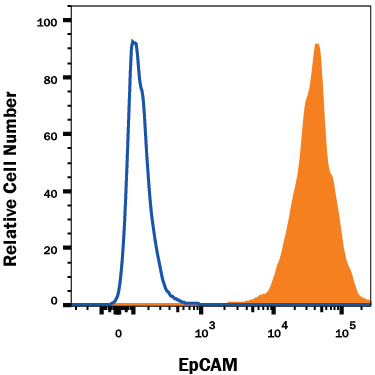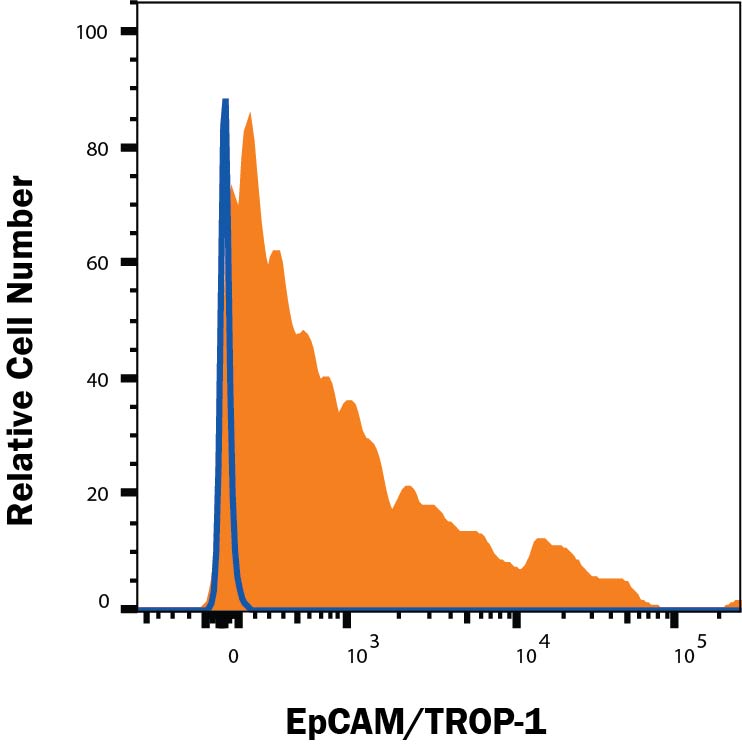Mouse
EpCAM/TROP-1 PE-conjugated Antibody
Mouse
EpCAM/TROP-1 PE-conjugated Antibody Summary
Applications
Please Note: Optimal dilutions should be determined by each laboratory for each application. General Protocols are available in the Technical Information section on our website.
Scientific Data
 View Larger
View Larger
Detection of EpCAM/TROP‑1 in 4T1 Mouse Cell Line by Flow Cytometry. 4T1 mouse breast cancer cell line was stained with Rat Anti-Mouse EpCAM/TROP-1 PE-conjugated Monoclonal Antibody (Catalog # FAB8998P, filled histogram) or isotype control antibody (Catalog # IC006P, open histogram). View our protocol for Staining Membrane-associated Proteins.
 View Larger
View Larger
Detection of EpCAM/TROP‑1 in mIMCD3 Mouse Cell Line by Flow Cytometry. mIMCD3 mouse kidney cell line was stained with Rat Anti-Mouse EpCAM/TROP-1 PE-conjugated Monoclonal Antibody (Catalog # FAB8998P, filled histogram) or isotype control antibody (IC006P, open histogram). View our protocol for Staining Membrane-associated Proteins.
Reconstitution Calculator
Preparation and Storage
- 12 months from date of receipt, 2 to 8 °C as supplied.
Background: EpCAM/TROP1
Epithelial Cellular Adhesion
Molecule (EpCAM), also known as ECD326 and TROP-1 is a 36-41 kDa member of the TROP family of meolcules (1, 2). It is a type I transmembrane glycoprotein that is found on embryonic stem cells and adult non-squamous epithelium such as (respiratory) psuedostratified, (mammary) cuboid, and (colon) simple columnar epithelium. In mouse, the molecule has also been reported on T cells, Langerhans cells and thymic epithelium. Mature mouse EpCAM is 292 amino acids (aa) in length. It possesses a 243 aa extracellular region that contains one thyroglobulin type I domain. Such domains are associated with cathepsin binding and inhibition (2). On the cell surface, EpCAM is reported to participate in TEM (Tetraspanin-enriched microdomain) formation in concert with CD44v6, CD9, ADAM10, Claudin-7 and TS8. It is also noted to form homodimers in-cis and homotetramers in-trans. Although this would suggest the EpCAM acts as an adhesion molecule, in effect it does not, instead acting as a disruptor of the E-Cadherin:cytoskeleton interaction, and thus promoting cell migration (1, 2). The extracellular domain (ECD) of EpCAM undergoes multiple cleavages, principally between Ser200 and Ala210 (3). Cleavage at the Arg80-Arg81 site does not generate a soluble fragment, but rather a disulfide-linked "heterodimer" (3). Cleavage after Gly264 in the juxtamembrane region is followed by secretase cleavage of the transmembrane fragment, generating an ICD that translocates to the nucleus (4). The ECD of mouse EpCAM shares 81% and 90% aa sequence identity with human and rat EpCAM, respectively.
- Schnell, U. et al. (2013) Biochim. Biophys. Acta 1828:1989.
- Martowicz, A. et al. (2015) Histol. Histopathol. Oct 23:11678 [ePub ahead of print].
- Schnell, U. et al. (2013) Biosci. Rep. 33:e00030.
- Hachmeister, M. et al. (2013) PLoS ONE 8:e71836.
Product Datasheets
FAQs
No product specific FAQs exist for this product, however you may
View all Antibody FAQsReviews for Mouse
EpCAM/TROP-1 PE-conjugated Antibody
There are currently no reviews for this product. Be the first to
review Mouse
EpCAM/TROP-1 PE-conjugated Antibody and earn rewards!
Have you used Mouse
EpCAM/TROP-1 PE-conjugated Antibody?
Submit a review and receive an Amazon gift card.
$25/€18/£15/$25CAN/¥75 Yuan/¥2500 Yen for a review with an image
$10/€7/£6/$10 CAD/¥70 Yuan/¥1110 Yen for a review without an image



